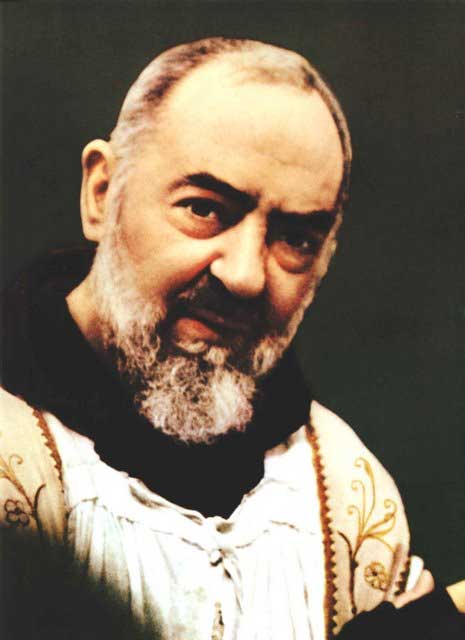Putting The Great Pio In Perspective
By Bret Thoman (Saint Francis Pilgrimages)

St. Pio of Pietrelcina, more warmly known simply as Padre Pio, is already one of the most well-known saints in history. Francesco Forgione was born on May 25, 1887, to a poor family in the farming village of Pietrelcina in southern Italy. His mother named him after St. Francis of Assisi.
As a child, Francesco wanted to become a priest, but his parents could not afford to pay for his education—a scenario all too common in rural Italy in that milieu. Although the Forgione family did not experience privation, there was no extra money for books and tutors. So his father emigrated to South America to work and be able to afford to send his son to seminary.
When he was fifteen years old, Francesco entered the Capuchin Franciscan Order, known for harsh penance and asceticism. At the beginning of the novitiate, he was given the religious name Pio (Pius).
After taking first vows, he was sent to Sant’Elisa a Pianisi for philosophy studies. There, he began to experience extraordinary graces and supernatural phenomena for which he is famous. While in prayer in the choir, he bilocated for the first time. He was transported spiritually to an aristocratic home in northern Italy where he witnessed the birth of a girl. She later became his spiritual daughter. He was also tormented by a vicious black dog and other evil presences.
At the same time, Fra Pio began to be frequently sick which forced him to return home. Back in Pietrelcina, on August 10, 1910, shortly after he had been ordained a priest, Padre Pio received the stigmata the first time. He was twenty-three. The next day, he and the parish priest prayed that the wounds would be removed. The physical wounds disappeared, though the pain remained.
When his health improved, he returned to the order in a friary in Foggia. But he continued to suffer from various ailments, which especially affected his lungs. Finally, a fellow friar invited him to come up to the mountainside convent of San Giovanni Rotondo, where the mountain air might be good for his health. Once he arrived, Padre Pio knew he would remain there for the rest of his life. In fact, the mystical phenomena multiplied.
In 1918, Padre Pio experienced what is known as Transverberation, or the piercing of the heart. People went to him in confession and recounted that Padre Pio could “read their souls”; that is, he knew their sins before they confessed them. He frequently prophesied and could foretell the future. There were stories of bilocation where Padre Pio would appear simultaneously in two places at the same time. He had the powers of healing, as well.
The phenomenon he is most known for took place on September 20, 1918. While Padre Pio was praying before a crucifix in the choir above the ancient church, he again experienced piercing pain in his hands, feet, and side. This time, his prayer that they would disappear went unanswered. Instead, the visible, open wounds remained on his body for fifty years.
His superiors ordered Padre Pio to undergo medical examinations. The doctors concluded that the wounds were inexplicable in that they did not heal or worsen over time. When asked about all these phenomena, Padre Pio often responded that they were a mystery even to him.
Padre Pio’s reputation as a mystic and healer quickly spread far and wide. People from all over began journeying to San Giovanni Rotondo seeking healings and miracles. Church authorities responded with prudence, which were perhaps excessive. After an eminent priest-doctor reported that Padre Pio’s stigmata were false, the Holy Office (today, the DDF) responded harshly. For two years, Padre Pio was forbidden from hearing confession, celebrating Mass in public, and from corresponding with his spiritual sons and daughters. Despite the suffering, he always obeyed. He believed that his superiors’ orders were the orders of Christ himself.
In 1933, Padre Pio’s prohibition on celebrating Mass in public was lifted by Pope Pius XI himself. He famously said, “I have not been badly disposed toward Padre Pio; I have been badly informed.” The following year, he was allowed again to hear confessions.
Beyond the extraordinary graces and miracles surrounding his life, Padre Pio believed that his greatest work was the construction of a hospital he built entirely through donations. Named the Casa Sollievo della Sofferenza (House for Relief of Suffering), Padre Pio worked tirelessly to help the sick.
Padre Pio died on September 23, 1968, a day he had foretold. One day earlier, his wounds had healed. Those who knew him believed this was a sign that his earthly mission was finished.
Padre Pio of Pietrelcina was beatified and canonized by St. John Paul II. It is known that the Polish pope was devoted to Padre Pio, and he even kept Padre Pio’s letters on his bedside nightstand.
Today, Padre Pio’s tomb in San Giovanni Rotondo is visited by millions of people each year. Many continue to receive miracles. Padre Pio’s continual intercession is a testament to what he frequently told his spiritual sons and daughters: “After my death I will make more noise. My real mission will begin after my death.”
No comments:
Post a Comment